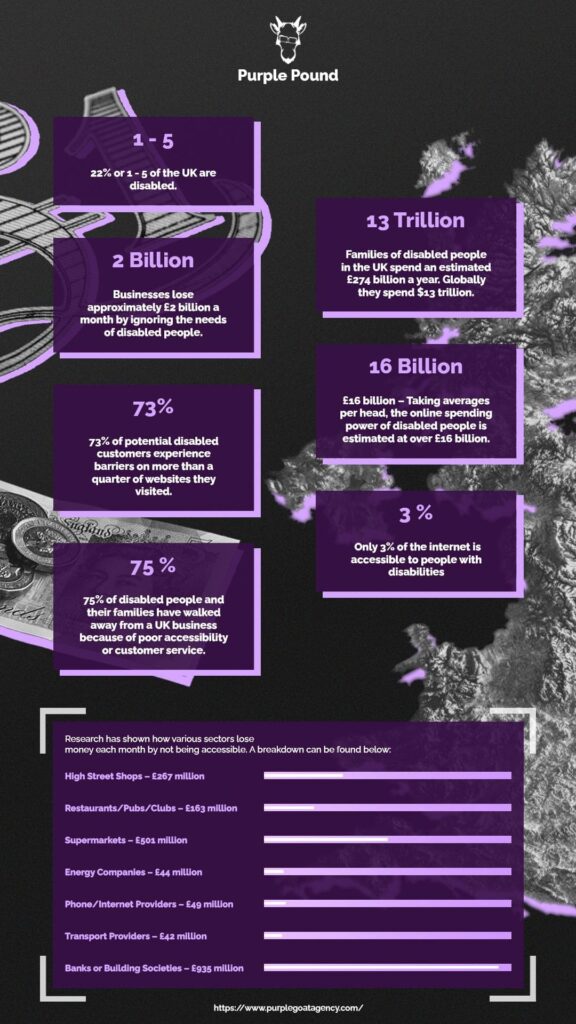In today’s digital age, the world of marketing is constantly evolving, and savvy marketers are always on the lookout for new opportunities to reach untapped markets. One such market that often goes overlooked is the “Purple Pound.”
In this article, we’ll delve into what the Purple Pound is, why businesses are missing out on the business of disabled customers, and why marketers must pay attention to this segment.
We’ll also explore 7 actionable steps marketers can take to ensure their campaigns are inclusive of their disabled audience.
What is The Purple Pound?
The Purple Pound refers to the collective spending power of disabled consumers. The term is a way to highlight the economic influence of this demographic – it’s a significant portion of the consumer market that is often underestimated by businesses and service providers.
Disabled individuals, along with their friends and families, make up a substantial segment of the population. Ignoring this demographic means missing out on a massive potential customer base. Families of disabled people in the UK are estimated to spend £274 billion a year, on a global scale this amount goes up to over £13 trillion.
A Missed Opportunity for Many Businesses and Marketers
Marketers aim to reach diverse audiences to drive business growth. Yet, the disabled community remains a significant and often untapped market that many companies overlook. Representing billions in spending power, this demographic is not only influential but also increasingly vocal about their brand preferences and loyalties. So, why do businesses continue to miss out on this lucrative market?
Why are Businesses Currently Missing Out on the Business of Disabled Customers?
The Underestimation of the Purple Pound
One of the main reasons marketers and businesses are currently missing out on the opportunity of the Purple Pound is simple – underestimation. Despite the disabled community representing a market segment worth billions, it’s frequently dismissed as ‘niche’ or secondary in importance. This oversight is often fuelled by a lack of awareness or preconceived notions about the purchasing power and needs of disabled individuals. The result is a glaring omission in market strategy, where businesses miss out on a substantial revenue stream and, more critically, contribute to a cycle of social exclusion.
Data is often a key driver and decision-maker in how businesses operate. Conducting simple insights and consumer research into how the disabled communities think and feel about your brand, product or service, would likely drive a lot more businesses to see the potential this market can offer their business, but many just don’t try and look into it int he first place.
Poor Accessibility (Digitally and Physically)
One of the primary reasons many businesses miss out on the Purple Pound is poor accessibility. This includes both digital platforms and physical locations. Websites and apps that aren’t designed with accessibility in mind exclude disabled users, making it challenging for them to engage with a brand or make purchases. From colour contrast to font choices, accessible web design considers thought and effort that a lot just don’t make.
Similarly, physical locations that lack wheelchair ramps, wider aisles, sensory friendly experiences, or tactile signage make it challenging, if not impossible, for disabled individuals to engage with a brand. These limitations not only lose immediate sales but also damage long-term relationships and word-of-mouth recommendations, effectively shrinking the brand’s potential market.
Not Disability Confident in Customer Services Approach
A customer’s interaction with a brand extends beyond just the product or service on offer; it includes the entire customer service experience. Businesses that lack disability confidence in their customer service approach are creating a barrier for disabled consumers. This lack of confidence may manifest as inadequately trained staff, insufficient or misapplied accessibility features, or a general lack of understanding of the diverse needs of disabled individuals. By not investing in disability awareness and training, companies miss the opportunity to build meaningful relationships with this demographic, thereby forfeiting their share of the Purple Pound.
Lack of Inclusivity and Diversity in Marketing
Another glaring issue, and one that we here at Purple Goat are very aware of, is the lack of inclusivity and diversity in marketing campaigns. Representation matters, and when disabled individuals don’t see themselves represented in advertising and marketing materials, they may feel excluded and less inclined to engage with a brand. And the same can happen with the general population, who will be more open to purchase from a brand if they consider it to be diverse and inclusive to everyone in society.
Why is The Purple Pound Important to Marketers?
Having explored the barriers that have caused businesses to overlook the significant potential of the Purple Pound, it’s crucial to shift our focus to why marketers should pay close attention to this often-undervalued demographic. The importance of tapping into the Purple Pound extends beyond mere revenue; it also touches on social responsibility, legal compliance, and opportunities for innovation and differentiation. Understanding and prioritising this market segment is not just a ‘nice to have’ but a ‘need to have’ for businesses aiming for comprehensive and sustainable growth.
Significant Buying Power
As we have already mentioned, The Purple Pound represents a substantial buying power. By tapping into this market (which is both substantial and underserved), marketers have the opportunity to reach 100% of their target audience. This inclusivity can lead to increased sales and brand loyalty.
Social Responsibility
Beyond financial gains and positive reflections on a company’s values and ethics, marketers should consider their social responsibility to ensure their products and services are accessible to all. Being inclusive and accommodating to disabled customers helps create a more inclusive world. Businesses and marketers that engage with this demographic in a meaningful way contribute to breaking down societal barriers and reducing stigma.
Legal Requirements
In many countries, there are legal requirements for businesses to ensure accessibility and inclusivity for disabled customers. Ignoring these legal obligations can lead to costly consequences both financially and to brand reputation.
Innovation & Differentiation
Embracing the Purple Pound can also be a source of innovation and differentiation. Companies that take the lead in addressing the needs of disabled customers can gain a competitive advantage in the market. Accessibility features of products and inclusive marketing efforts can be a unique selling proposition (USP), differentiating a brand in an increasingly crowded marketplace.
Brand Loyalty & Advocacy
Disabled consumers, like any other demographic, appreciate when a brand goes the extra mile to meet their specific needs. This can result in a high degree of brand loyalty and positive word-of-mouth advocacy, both of which are invaluable in today’s market. When consumers feel seen and valued, they are more likely to stick with a brand and recommend it to others.
7 Simple Things Marketers Can Do to Target the Disabled Community
Understanding the importance of the Purple Pound is just the starting point; the next step is taking actionable measures. While creating fully inclusive marketing campaigns may seem daunting, there are straightforward ways to make a significant difference.
- Accessible Social Channels: Ensure that your social media channels and online platforms are accessible to all, including those with disabilities. Use alt text for images, provide closed captions for videos, and use accessible website design practices. Check out our guides for some top tips on making your TikTok and Instagram accessible.
- Work with a Disability Marketing Agency: Consider partnering with a specialised agency like Purple Goat that understands the nuances of marketing to disabled audiences. We can help with the creation of inclusive marketing influencer campaigns or overall brand strategies, but we can also provide DE&I training to make your company more understanding and inclusive as a whole, including in your marketing.
- Use Inclusive Language: Avoid using language that may be exclusive or stigmatising. Be mindful of the words and phrases you use in your marketing materials.
- Carry Out Market Research of Disabled Customers: Understand your disabled customers’ needs, preferences, and behaviours through thorough market research. This can help tailor your campaigns effectively.
- Accessible Product Messaging, Design, and Packaging: Ensure that product messaging, design, and packaging are accessible and considerate of disabled consumers.
- Feature Disabled People in Marketing Materials: Show representation by featuring disabled individuals in your marketing materials. This demonstrates inclusivity and authenticity.
- Ensure Authentic Inclusivity: Avoid “diversity washing” by genuinely embracing inclusivity throughout your organisation, from marketing to product development.
The Wider Picture
It’s not just a business’s marketing team that needs to make changes to tap into the Purple Pound. The entire organisation must prioritise inclusivity and accessibility. From leadership setting the tone and strategy, to customer service tailoring their approach, and even to procurement and supply chain management sourcing accessible products—every department has a role to play. This isn’t merely about isolated changes; it’s about a cultural shift within the organisation. By embedding inclusivity into the core values and operations, businesses not only unlock the potential of the Purple Pound but also set themselves up for long-term success and a positively perceived brand.
Concluding thoughts – The Purple Pound & Marketing
The Purple Pound represents a vast and largely untapped market that holds immense potential for businesses.
The need for more inclusive marketing isn’t just about tapping into this significant spending power; it’s also about fulfilling social responsibilities and legal obligations. By embracing inclusivity at all organisational levels, not just within the marketing department, businesses can foster meaningful relationships with disabled consumers, tap into new markets, and enrich their brand value. Businesses and marketers that begin to understand the value of the Purple Pound and of building inclusive marketing, as a result, can get a step ahead – not only reaping the financial and brand image benefits but also contributing to building a more inclusive society.
To learn more about effectively marketing to disabled audiences and maximising the Purple Pound, contact Purple Goat, your disability marketing experts.
We’re here to help you unlock this valuable market segment and grow your business.

Graphic Description:
The image has a dark background with a map of the UK and money graphics. At the top is the Purple Goat, goat head logo and the title ‘Purple Pound’. Overlayed are the most recent statistics relating to the Purple Pound. In seven purple boxes with lilac edges are the statistics:
- 1-5: 22% or 1-5 of the UK are disabled
- 2 Billion: Businesses lose approximately £2 billion a month by ignoring the needs of disabled people.
- 13 trillion: Families of disabled people in the UK spend an estimated £274 billion a year. Globally they spend $13 trillion.
- 16 billion: taking average per head, the online spending power of disabled people is estimated at over £16 billion
- 73% – 73% of potential disabled customers experience barriers on more than a quarter of the websites they visited.
- 75% – 75% of disabled people and their families have walked away from a UK business because of poor accessibility or customer service.
- 3% – Only 3% of the internet is accessible to people with disabilities.
Below is a line chart showing how various sectors lose money each month by not being accessible:
- High street shops – £267 million
- Restaurants/Pubs/Clubs – £163 million
- Supermarkets – £501 million
- Energy companies – £44 million
- Phone/Internet providers – £49 million
- Transport providers – £42 million
- Banks or building societies – £935 million
At the bottom is the Purple Goat website link.




